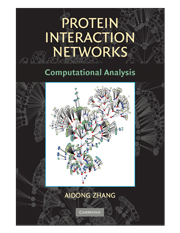Book contents
- Frontmatter
- Contents
- Preface
- 1 Introduction
- 2 Experimental Approaches to Generation of PPI Data
- 3 Computational Methods for the Prediction of PPIs
- 4 Basic Properties and Measurements of Protein Interaction Networks
- 5 Modularity Analysis of Protein Interaction Networks
- 6 Topological Analysis of Protein Interaction Networks
- 7 Distance-Based Modularity Analysis
- 8 Graph-Theoretic Approaches to Modularity Analysis
- 9 Flow-Based Analysis of Protein Interaction Networks
- 10 Statistics and Machine Learning Based Analysis of Protein Interaction Networks
- 11 Integration of GO into the Analysis of Protein Interaction Networks
- 12 Data Fusion in the Analysis of Protein Interaction Networks
- 13 Conclusion
- Bibliography
- Index
5 - Modularity Analysis of Protein Interaction Networks
Published online by Cambridge University Press: 28 January 2010
- Frontmatter
- Contents
- Preface
- 1 Introduction
- 2 Experimental Approaches to Generation of PPI Data
- 3 Computational Methods for the Prediction of PPIs
- 4 Basic Properties and Measurements of Protein Interaction Networks
- 5 Modularity Analysis of Protein Interaction Networks
- 6 Topological Analysis of Protein Interaction Networks
- 7 Distance-Based Modularity Analysis
- 8 Graph-Theoretic Approaches to Modularity Analysis
- 9 Flow-Based Analysis of Protein Interaction Networks
- 10 Statistics and Machine Learning Based Analysis of Protein Interaction Networks
- 11 Integration of GO into the Analysis of Protein Interaction Networks
- 12 Data Fusion in the Analysis of Protein Interaction Networks
- 13 Conclusion
- Bibliography
- Index
Summary
INTRODUCTION
The component proteins within protein-protein interaction (PPI) networks are associated in two types of groupings: protein complexes and functional modules. Protein complexes are assemblages of proteins that interact with each other at a given time and place, forming a single multimolecular machine. Functional modules consist of proteins that participate in a particular cellular process while binding to each other at various times and places. The detection of these groupings, known as modularity analysis, is an area of active research. In particular, the graphic representation of PPI networks has facilitated the discrimination of protein clusters through data-mining techniques.
The methods of data mining can be applied to identify various aspects of network organization. For example:
Proteins located at neighboring positions in a graph are generally considered to share functions (“guilt by association”). On this basis, the functions of a protein may be predicted by examining the proteins with which it interacts and the protein complexes to which it belongs.
Densely connected subgraphs in the network are likely to form protein complexes that function as single units in a particular biological process.
Investigation of network topological features can shed light on the biological system [29]. For example, networks may be scale-free, governed by the power law, or of various sizes.
A cluster is a set of objects that share some common characteristics. Clustering is the process of grouping data objects into sets (clusters); objects within a cluster demonstrate greater similarity than do objects in different clusters. In a PPI network, these sets will be either protein complexes or functional modules.
- Type
- Chapter
- Information
- Protein Interaction NetworksComputational Analysis, pp. 50 - 62Publisher: Cambridge University PressPrint publication year: 2009
- 1
- Cited by



